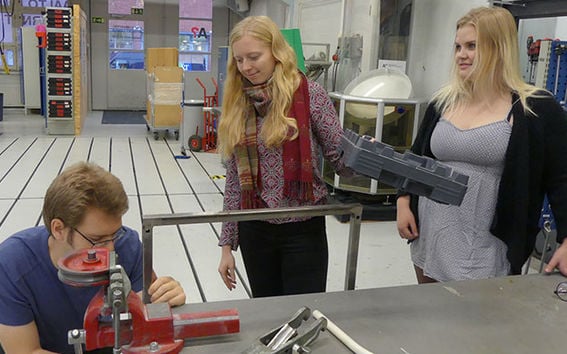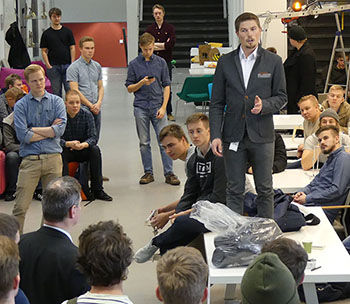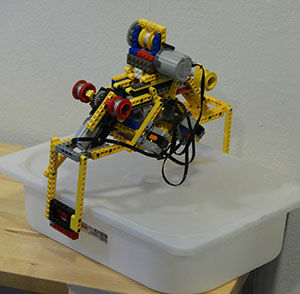Konecranes assignment inspired students to build smart prototypes

Almost 200 students participated in the product design course of the School of Engineering this fall where they learned about the design process of a technical product and how to apply it. For the first time at such an early stage of studies the students got an actual industry problem to tackle.
The assignment given by Konecranes was to design an assistive device for their overhead crane with which objects can be lifted automatically from a loading pallet to a machine tool and back. “Konecranes has for long worked with students, but usually with one group at a time. Giving a task for 30 student groups was new to us as well”, says Ekku Rytkönen (in the picture below standing on the table), Innovation Specialist at Konecranes.

In spring 2016 Konecranes and Aalto University agreed on education and research cooperation in industrial internet. For this purpose Konecranes donated a smart overhead crane to the Aalto Industrial Internet Campus where students got an introduction to the functionalities of the crane and got to use the lab facilities to build their prototypes.
“We didn’t get to use the crane itself, but saw how it works. That helped us in understanding better what Konecranes expected from us. The product design course was fun and more practical than other more theoretical courses I’ve attended. Every week our group worked on the assignment – there was a lot of information gathering but also room to be creative”, tells Emilia Julin, second year student of mechanical and structural engineering.
Emilia Aarnio thinks that the most enjoyable was to work in the lab building the prototype. “An engineer must know how to solve problems in practise and this assignment taught us exactly that. Even if our prototype design was very simple we run into a couple of problems when building it. I only wish we would have been given more time”, ponders Emilia.
Konecranes was expecting to receive a big bunch of well formulated proposals, but the results truly surprised them. “We didn’t anticipate for the groups to build demos and prototypes. Some of them were so advanced that you could think they were built on the year long project. This course only lasted less than two months and was done in groups of six students”, explains Ekku Rytkönen.
Professor Petri Kuosmanen feels that cooperation with companies from the first study year onwards is important because topics given by them are fresh and based on real industrial needs. He says that students are motivated to solve industrial cases also because they give a chance to familiarize oneself to the work environment the student will after graduation move on to.
Ekku Rytkönen, Innovation Specialist at KonecranesWe cooperate with universities not only to get fresh new ideas and creative solutions but also to increase the employer brand of Konecranes and attract the best talents.
